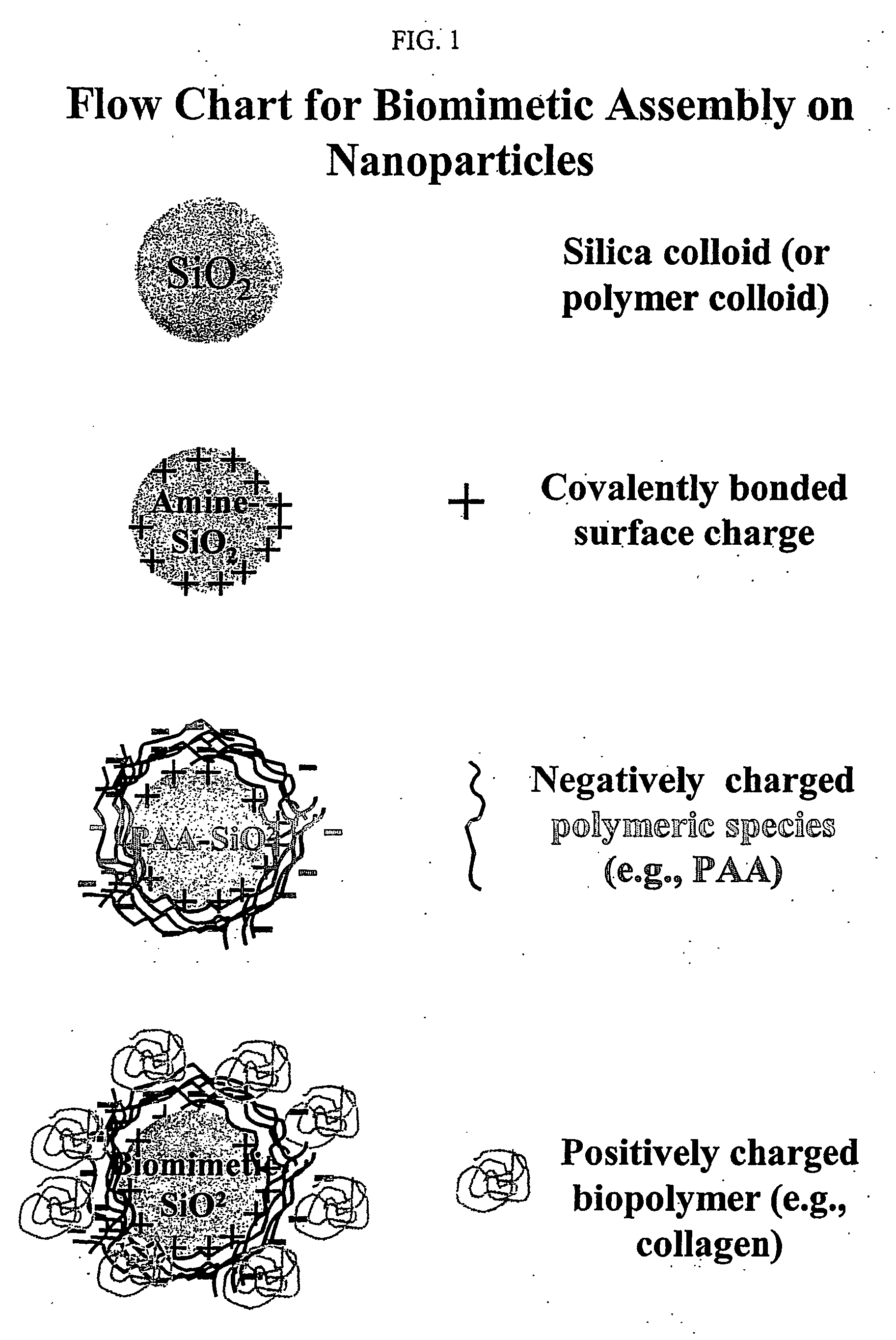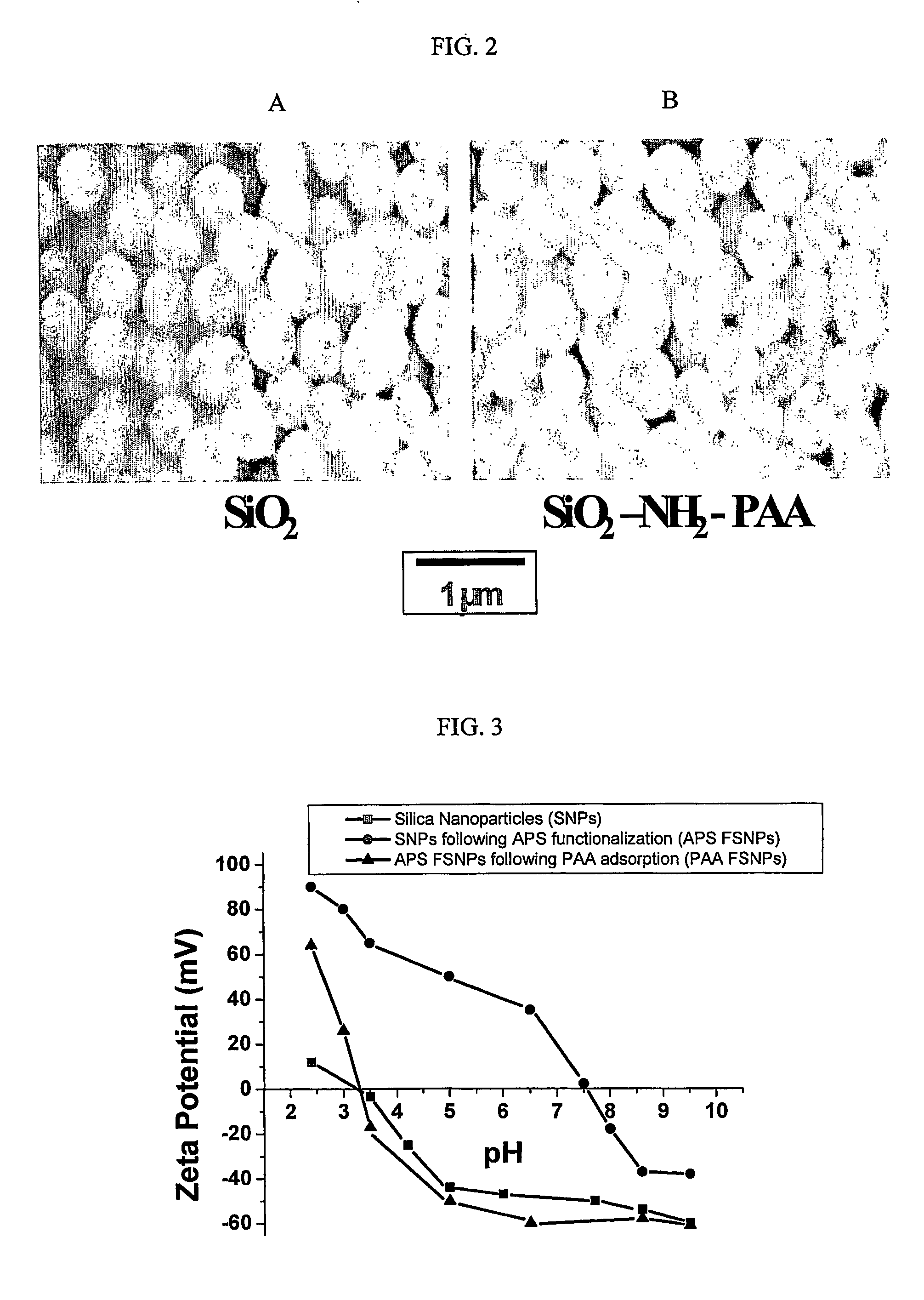Biommetic hierarchies using functionalized nanoparticles as building blocks
a functionalized nanoparticle and biomimetic technology, applied in the direction of biocide, peptide/protein ingredients, capsule delivery, etc., can solve the problems of lack of control over the microstructure of the compound at the nanoscopic level, lack of suitable biomimetic interface for attaching cells, and poor sub-micron definition of conventional coating techniques, etc., to enhance the response of bone cells, enhance biofunctionality, and precise thickness
- Summary
- Abstract
- Description
- Claims
- Application Information
AI Technical Summary
Benefits of technology
Problems solved by technology
Method used
Image
Examples
example 1
Preparation of Functionalized Silica Nanoparticles (FSNP)
[0073] Silica particles (SNPs) having 600 nm in diameter were prepared using a modified Stober process. (See W.Stoeber, A. Fink, Controlled Growth of Monodispersed Silica Spheres in the Micron Size Range, J. of Colloid and Interface Science, 26, 62-69, (1968)). 50 ml of a 364 mM tetraethylorthosilicate (TEOS) / ethanol suspension were added to a separate flask containing a 50 ml solution of ammonium hydroxide (11.7 g) and de-ionized water (14.4 g) in ethanol. This 100 ml mixture was stirred for two hours. Following stirring, 75 ml of the resultant 100 ml suspension was saved for amine modification to prepare amine functionalized silica nanoparticles. The remaining 25 ml were washed 3 times with de-ionized water with intermediate centrifugation, and then saved for further experimentation and characterization.
[0074] The surface of the 600 nm SNPs was functionalized by reaction of the surface with aminopropyltriethoxysilane (APS)...
example 2
Preparation of poly(acrylic) acid functionalized silica nanoparticles (SiO2—NH2—PAA or PAA FSNP)
[0075] The surface of the Amine FSNP (as described in Example 1) was further functionalized through electrostatic adsorption of poly(acrylic) acid (PAA). (See R. Denoyel, J. C. Glez, P. Trans, Grafting γ-Aminopropyltriethoxysilane onto silica: Consequence of Polyacrylic Acid Adsorption, Colloids and Surfaces A: Physicochemical and Engineering Aspects, 197, (2002), 213-233).
[0076] A PAA / ethanol solution was prepared by mixing 1ml of PAA with 10 ml of ethanol, which was then filtered using a 200 m syringe filter. 10 ml of the filtered solution were added to 50 mi of the Amine FSNP / ethanol suspension. Following two hours of stirring, the suspension was washed 3 times with de-ionized water with intermediate centrifugation. 25 ml of the resultant 50 ml PAA FSNP suspension were saved for collagen modification (see Example 4). The remaining 25 ml were saved for further experimentation and char...
example 3
Particle Characterization
[0077] Scanning Electron Microscopy (SEM) and Energy Dispersive Spectroscopy (EDS) were performed using a JEOL 6300F FEG HRSEM (JEOL Ltd., Tokyo, Japan) equipped with a PGT EDS System (Oxford Instruments, PLC, Oxford, UK). Samples were prepared by placing a drop of particle suspension onto an aluminum stud covered with carbon tape. The solvent was then evaporated in a drying oven at 70° C. The dried stud containing dried particles was coated with Au / Pd using a sputter coater. The samples were analyzed at an accelerating voltage of 51 kV.
[0078] Zeta Potential Measurements were performed using a ZetaSizer 3000 HSA analyzer (Malvern Instruments, Southborough, Mass.). Samples were prepared by diluting 4 ml of particle suspension with 40 ml of de-ionized water. The pH of the suspension was adjusted to the desired values before each measurement using ammonium hydroxide and acetic acid.
[0079] SEM micrographs of the SNPs and PAA FSNP are shown in Fig. 2. The SNP ...
PUM
| Property | Measurement | Unit |
|---|---|---|
| diameter | aaaaa | aaaaa |
| molar ratio | aaaaa | aaaaa |
| molar ratio | aaaaa | aaaaa |
Abstract
Description
Claims
Application Information
 Login to View More
Login to View More - R&D
- Intellectual Property
- Life Sciences
- Materials
- Tech Scout
- Unparalleled Data Quality
- Higher Quality Content
- 60% Fewer Hallucinations
Browse by: Latest US Patents, China's latest patents, Technical Efficacy Thesaurus, Application Domain, Technology Topic, Popular Technical Reports.
© 2025 PatSnap. All rights reserved.Legal|Privacy policy|Modern Slavery Act Transparency Statement|Sitemap|About US| Contact US: help@patsnap.com



